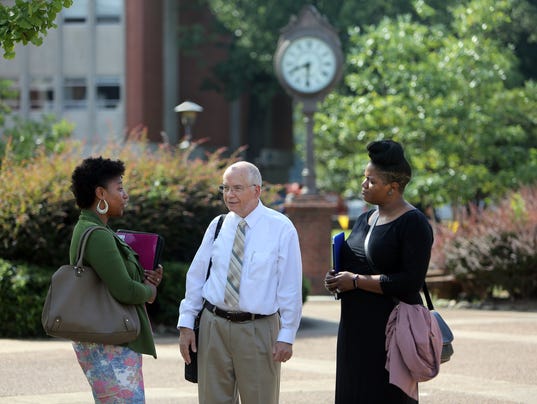Angela Wheeler-Lester, 44, works from 8 a.m. to 4:30 p.m. then does her assignments for her two online classes from 6:45 p.m. to 8 p.m. She studies for 90 minutes each day and reviews chapters every weekend.
The mother of two said online courses allow her to stay active in her daughter’s school activities. When her son was in school, she was not able to attend as many of his activities because she took college classes on campus.
“Studying online cost more than attending college on campus. However, the benefit from studying online outweighs the added cost,” Lester said. “Many professors online require more of your input and time, by establishing a schedule and setting goals, that makes the challenge less stressful.”
Lester is one of more than a million students taking at least one online course in the fall of 2016.
“Online courses are convenient and allow me to easily take care of home and family while working on my Master’s in Human Resource Management,” said Lester, who is enrolled at Webster University and has a 3.5 GPA.
Across the country, colleges recorded a 3.9-percent increase in the number of students taking online courses from 2013 to 2014, according to “Online Report Card: Tracking Online Education in the United States,” an annual report released in February by the Babson Survey Research Group. About 5.8 million students were taking at least one distance learning course in the fall 2014, according to the report. More than one in four students now take at least one distance learning course.
The University of Memphis, Christian Brothers University and Southwest Tennessee Community College offer online courses or hybrid courses, while Rhodes College and Lemoyne-Owen College do not.
About 7,313 students are enrolled in at least one online course at the University of Memphis in the fall 2016 – up 15.2 percent from the previous fall semester. The growth rate is the highest the university has seen in the past five years.
“The quality of the online experience has improved,” said Roy Bowery, U of M director of distance learning. “Our goal is to make the online learning experience very comparable and in some cases better than an on-ground experience when possible.”
The University of Memphis had 247 unique online courses offered during the 2011-2012 school year, the college currently has 320 unique online courses, a 30 percent growth.
“Our programs are convenient to a student’s family demands, career demands, and community involvement demands,” Bowery said. “At the University of Memphis, we bend over backwards to help that person earn that degree.”
With about 1,400 more students enrolled in at least one online course since 2011, Bowery said the university has recognized that some adults are working, have children, and are studying late when classes are not offered.
Students are switching from taking courses in classrooms to their laptops for a number of reasons, according to Bowery. Online students are typically older, full-time working adults, have families, provide community and civic duties, and have been out of high school for several years. According to Bowery, the flexibility of the University of Memphis’ online programs allows for adult students to satisfy existing responsibilities for family and career and still be able to study at convenient times and places.
“Some students live far away and are unable to travel, others use it as a convenience, and for others this is the only course delivery method available,” said Don Myers, director for planning and institutional effectiveness at Southwest Tennessee Community College.
Southwest currently has 1,960 students enrolled in their 205 online courses, compared with 2,067 students and 193 courses in 2015. According to Bowery, while online classes are engaging and convenient, they do require a high level of self-discipline and motivation. Chene Spivey, 22, leaves his job at 9:30 p.m. and immediately starts on his homework for his online class.
“Since I work to pay for school along with other living expenses, I have to not only demonstrate, but maintain discipline because of the rigorous balance between school and work,” said Spivey, who has taken four online courses at the University of Memphis.
Although the University of Memphis online programs do not require students to come to campus for enrollment, course registration, fee payments, class attendance, or fulfillment of course work, they are still expected to work as hard as a student who attends class.
The design, development, and delivery of online courses are approached in significantly different ways compared to an on-ground program. According to Bowery, all University of Memphis online programs and courses must be reviewed and approved by the offices of Vice Provost of Academic Innovation and Support Services and Distance Learning to ensure they are designed to address online student demographics and maintain appropriate rigor.
With the growth of online courses at the University of Memphis, the online faculty has also grown 11 percent. During the 2011-2012 academic year the university had 378 online faculty compared to the 419 online faculty in 2016.
Bowery said all online faculty are provided professional development opportunities that provide the understanding and skill sets required to effectively teach online.
Degrees and transcripts for online programs are identical in substance and appearance to those earned by on-ground students, and online degrees course content is equivalent to on-campus courses.
[Source:-Commercial apple]

